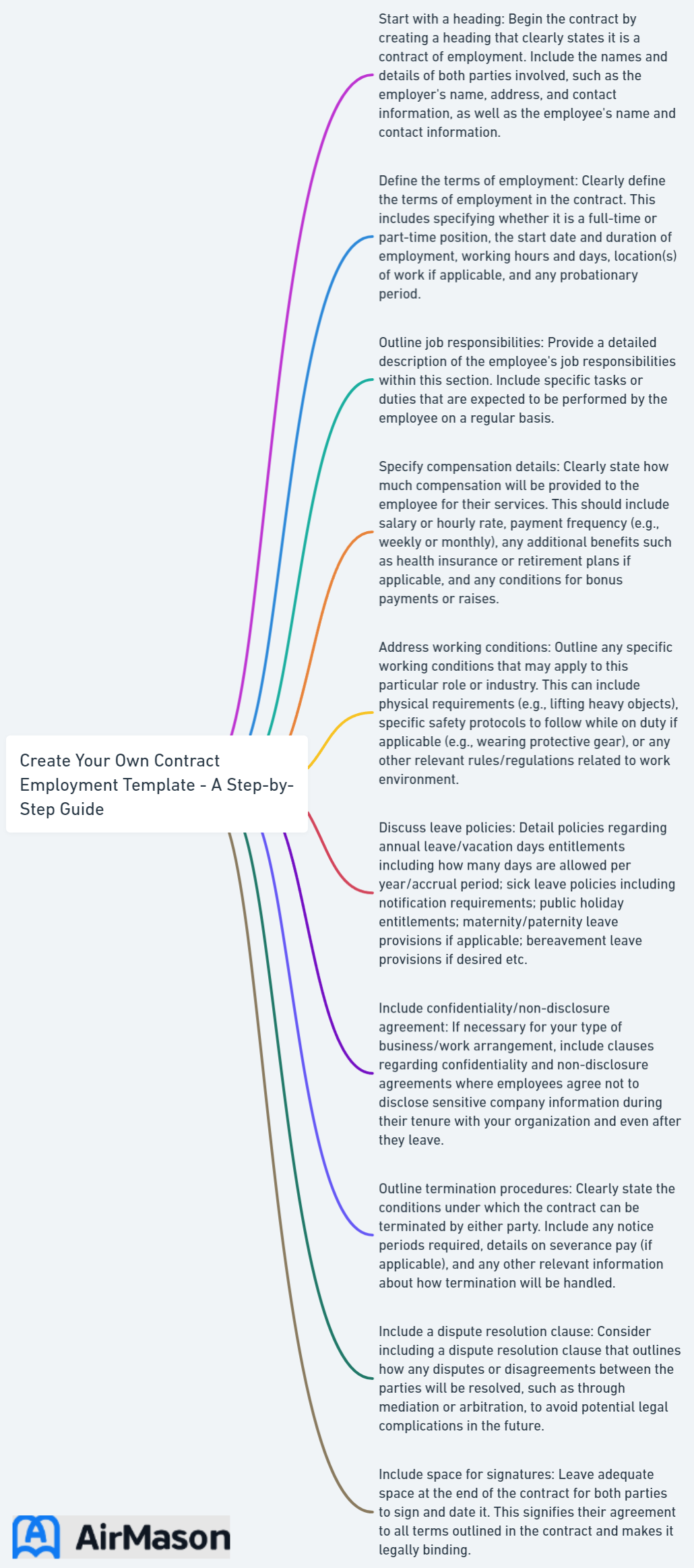
Entering a new employment relationship can be both exciting and daunting. One crucial aspect that should never be overlooked is the employment contract. This legally binding document serves as the foundation for the employer-employee relationship, outlining rights, responsibilities, and expectations for both parties. In this guide, we will delve into the importance of employment contracts, the different types available, and how to create a customized contract employment template that suits your organization’s needs. Let’s embark on this journey together to ensure a smooth and successful hiring process.
Key Takeaways
- Understand the fundamentals of employment contracts and their key elements.
- Customize an employment contract template to suit your organization’s needs, adhering to legal considerations, company policies & regulations.
- Present and sign the contract with a formal offer letter before securely storing it for easy management.
Contracts Definition
When exploring the legal landscape, understanding contracts is paramount. Contracts definition, is, legally binding agreements between two or more parties. These agreements outline the terms, conditions, and obligations that each party must adhere to, providing a framework for a wide range of transactions and relationships. A clear contracts definition is essential for navigating various aspects of business, employment, and personal interactions. It serves as the foundation for ensuring mutual understanding and accountability. In essence, contracts definition encapsulates the rules and expectations that govern the relationships between parties, contributing to a fair and just exchange of goods, services, or promises.
Understanding Employment Contracts
An employment contract is a document that employment contract outlines the rights, responsibilities, and obligations of both the employer and the employee during a period of employment. Also known as an employment agreement contract, it establishes a legally binding agreement between the parties to remunerate the employee for services rendered. The primary components of an employment contract include Job Title and Responsibilities, Compensation and Benefits, and Termination and Notice Period. A well-drafted employment contract can help both employers and employees avoid potential misunderstandings and disputes, fostering a harmonious working relationship. To ensure a comprehensive and legally sound document, consider using an employment contract agreement template.
Providing clarity and protection for both the employer and the employee, employment contracts play a vital role in the hiring process. They help set expectations and establish a framework for the employment relationship. Moreover, US companies hiring citizens and residents must adhere to IRS requirements, which the employee agrees to follow. Thus, a comprehensive and accurate employment contract is key to maintaining compliance with employment laws and regulations.

Types of Employment Contracts
Employers may utilize various types of employment contracts depending on their requirements and the type of work involved. Some common types of employment contracts are:
- Implied employment contract: an unwritten agreement that is inferred from the actions or statements of the employer and employee.
- Permanent part-time contracts: for employees who do not fulfill the full-time hours stipulated by the relevant jurisdiction and have no expiration date set for the employment period.
- Fixed-term contracts: have a predetermined end date for the employment of the employee and must comply with the federal minimum wage requirements.
- At-will employment agreements: offer flexibility to both employees and employers. They can end their association without any cause.
- Trial periods: typically lasting three to six months, can be included in employment contracts, allowing employers to release employees who cannot fulfill job requirements. To ensure compliance with legal requirements, employers can refer to an employment contract sample for guidance.
Selecting the appropriate contract for each individual employee requires a sound understanding of the different types of employment contracts. The conditions of an employment contract for a worker may appear similar but can contain contrasting stipulations based on whether they are hired on a permanent or temporary basis and whether it is a full-time or part-time role. Choosing the right type of employment contract enables employers to provide their employees with the necessary protections and benefits, while also staying compliant with employment laws and regulations.
Key Elements of an Employment Contract

An employment contract should include essential elements such as Job Title and Responsibilities, Compensation and Benefits, and Termination and Notice Period. These elements serve as the backbone of the employment relationship, setting expectations and providing a clear understanding of the rights and responsibilities of both the employer and the employee.
The subsequent subsections will explore each of these key elements, offering guidance on their effective integration into your employment contract.
Job Title and Responsibilities
A well-drafted employment contract should clearly define the employee’s job title and outline their responsibilities. By specifying the position the employee will hold upon hire and the number of hours they are required to work each week, employers can set expectations and avoid confusion. It is essential for the employee to carry out all essential job functions and duties, and the employer may add other duties to the employee’s position if necessary. Allocating percentages to each duty in the contract can further clarify responsibilities and expectations.
A clear job title and responsibilities section in the employment contract is vital for both the employer and the employee. It helps ensure that the employee is aware of their obligations and understands what is expected of them. It also enables the employer to evaluate the employee’s performance based on the agreed-upon responsibilities, creating a transparent and fair working environment.
Compensation and Benefits
Compensation is a critical aspect of an employment contract, as it stipulates the amount of money the employee will be remunerated. To avoid potential misunderstandings regarding the new hire’s first or second paycheck, it is advisable to include compensation details in the employment contract. Upon completion of the probationary period, an employee becomes eligible for health and other benefits. Additional benefits may include flexible working hours, remote working, and other incentives.
Understanding the “going rate” for a profession in the employer’s market is crucial in determining the appropriate salary to offer. By outlining the compensation and benefits in the employment contract, employers can ensure that their employees are adequately rewarded for their work, fostering job satisfaction and employee retention.
Termination and Notice Period
Termination procedures, including notice periods and grounds for termination, should be specified in the employment contract. Termination can be undertaken by either party upon the provision of written notice. Probationary periods, typically lasting three to six months, allow an employer to terminate an employee without cause, notice, or severance pay. In the United States, it is customary for probationary periods to be 90 days. Upon completion of the probationary period, the employer shall evaluate the employee’s performance to decide if they will remain as a regular employee.
A well-defined termination and notice period in the employment contract is vital for both parties. It provides a clear understanding of the conditions under which the employment relationship may end and offers protection to both the employer and the employee. It also helps prevent potential disputes and misunderstandings, ensuring a smooth transition during the termination process.
Customizing Your Employment Contract Template

For a successful and compliant hiring process, it’s crucial to create an employment contract tailored to your organization’s needs. The next subsections will offer tips for customizing your employment contract template, covering aspects such as template selection, modification of terms and conditions, and the addition of company-specific details.
Choose the Right Template
It’s important to pick the right employment contract template based on your contract type requirements. Various types of employment contract templates are available, including:
- Full-time permanent contracts
- Part-time contracts
- Director’s service agreements
- Fixed-term contracts
- Zero-hours contracts
- Casual work contracts
These templates can be sourced from websites such as eForms, PandaDoc, Legal Templates, TemplateLab, LawDepot, Betterteam, and Workable.
The nature of the job and the specific terms and conditions to be included should be considered when choosing an employment contract template. For instance, a contract for a full-time permanent position may involve stipulations related to salary, benefits, and job security, while a contract for a temporary or freelance position may concentrate more on project scope, payment terms, and termination clauses. Be sure to thoroughly research available templates and select the one that best suits your organization’s requirements and the position being offered.
Modify the Terms and Conditions
After selecting the suitable employment agreement template, aligning the terms and conditions with your company’s policies and practices becomes the next important step. The essential elements to be altered in an employment contract template encompass:
- The duration of employment
- Salary or wages
- General job responsibilities
- Work schedule
- Benefits
- Confidentiality
- Non-compete agreement
- Severance terms
To ensure that the terms and conditions of the employment contract are in accordance with the company’s policies and practices, consider compliance with state and local laws pertaining to employment. Also, avoid using intricate legal terminology, which can lead to misunderstandings and ambiguity.
Customizing the terms and conditions of the employment contract allows you to create a document that accurately mirrors your organization’s values and expectations, thus paving the way for a successful and legally compliant hiring process.
Add Company-Specific Details
Incorporating company-specific details into your employment contract, such as logos, branding, and unique clauses, helps establish and advance your employer brand. This allows your company to display its distinctive value proposition, culture, and values to prospective employees, fostering trust and credibility. Including branding elements in the contract creates a unified and consistent brand experience for the employee, contributing to employee retention and attracting top talent.
When adding company-specific details, be mindful of common missteps, such as:
- Neglecting to take into account regulations and legal requirements
- Constructing a nebulous contract that is deficient in precise details
- Not correctly ascertaining the type of agreement
- Not adhering to employment legislation
- Overlooking regulations
By paying attention to these potential pitfalls and incorporating your organization’s unique identity into the employment contract, you can create a document that represents your company and its values while ensuring a successful and compliant hiring process.
Legal Considerations and Compliance
Ensuring legal compliance and seeking legal advice when drafting employment contracts are important steps to protect your company and avoid potential legal issues. Consulting with an employment lawyer after finishing the initial version of the employment contract can help ensure the contract is compliant with all relevant regulations and safeguard your business from potential litigation. Companies must possess an allocated EIN prior to employing any new personnel.
In addition to consulting with an employment lawyer, it is essential to:
- Understand the necessities for legally binding alterations
- Evaluate the type of alteration
- Communicate with the employer
- Guarantee legal protection
- Consult legal resources if necessary
By adhering to legal considerations and compliance requirements, you can ensure that your employment contract is legally sound, protecting both your organization and the employee.
Reviewing and Finalizing the Contract
It’s important to review, finalize and make any necessary revisions to the employment contract before presenting it to the employee. To ensure every detail is captured accurately in the contract, consider individualizing the contract, clearly articulating the basis of employment, incorporating provisional clauses, reviewing and revising, and elucidating job duties. Also, be mindful of common errors when finalizing an employment contract, such as neglecting to take into account regulations and legal requirements, not revising the contract to reflect changes in laws or company policies, and using outdated or generic contract templates.
After thorough review, it is time to finalize the contract. Make any necessary revisions and ensure that the contract accurately reflects any changes in the employment relationship, such as modifications to job duties, remuneration, or advantages. Reviewing and finalizing the employment contract ensures its accuracy, comprehensiveness, and legal compliance, thereby facilitating a successful hiring process.
Presenting and Signing the Employment Contract
After reviewing and finalizing the employment contract, it should then be presented to the employee. Begin with a formal offer letter that contains all the relevant business details, outlining the job information, including the employee’s name, job title, and job description. Additionally, include compensation and benefits information, as well as time off, sick days, and vacation policies. Ensure that the contract includes a requirement for resolving disputes and clearly states the start date and, if applicable, the end date of a fixed contract.
When presenting the employment contract, follow these steps:
- Address any concerns or questions the employee may have.
- Foster open communication and afford clarification.
- Address any particular concerns raised by the employee.
- Record discussions and any agreements reached.
- Seek legal counsel if necessary.
Once both the employee and the employer are satisfied with the terms and conditions, obtain signatures from both parties to make the employment contract legally binding.
Storing and Managing Signed Contracts
Upon signing the employment contract, secure storage and proper record maintenance are essential for easy access and management. Recommended practices for securely storing signed employment contracts include:
- Centralizing all contracts in a secure electronic repository
- Implementing role-based security to control access
- Ensuring all contract data is encrypted
- Utilizing a secure password-protected office computer to store digital copies of signed contracts
Typically, employers adhere to a 7-year rule for purging terminated employee files, which encompasses signed employment contracts. However, it is advisable to keep employment contracts for a minimum of 1 year. By securely storing and managing signed contracts, you can protect your organization’s confidential information and ensure easy access to important documents when needed.
What Are Contract Documents
When delving into the realm of construction and project management, understanding “what are contract documents” is fundamental. These documents serve as the blueprint for any successful project, encompassing a comprehensive set of papers that outline the terms, conditions, and specifications of a contractual agreement. In essence, “contract documents” refer to the written record that defines the relationships, responsibilities, and expectations among various project stakeholders. These critical papers typically include the project specifications, drawings, terms and conditions, and any additional supporting documentation necessary for clarity and legal purposes. Clear and thorough contract documents are crucial for mitigating disputes, ensuring project success, and fostering effective communication among all parties involved.
Summary
In conclusion, creating a comprehensive and legally compliant employment contract is an essential part of the hiring process. By understanding the different types of employment contracts, customizing your contract template, and ensuring legal compliance, you can establish a solid foundation for a successful employer-employee relationship. Remember to review and finalize the contract, present it to the employee for signing, and store it securely for future reference. By following these guidelines, you will pave the way for a smooth and successful hiring process, fostering a harmonious and productive work environment for your organization.
Frequently Asked Questions
How do you write a simple employment contract?
To write a simple employment contract, start by titling the agreement and identifying the parties involved. Then, list the terms and conditions of the contract, including working hours, job responsibilities, and any confidentiality clauses. Lastly, include details regarding compensation, such as the rate of pay and frequency.
Can you make your own contract of employment?
It is possible to create your own contract of employment, as both parties need to agree and sign the contract for it to be effective. Freelancers and independent contractors can provide their own terms of employment as well.
How do you write a contract for a contract employee?
Creating an Employment Contract should include terms such as type and rate of compensation, frequency of payment, vacation time, specified work hours and location, employee responsibilities, length of a probationary period, confidentiality, non-solicitation or non-competition clauses, and consulting with a lawyer. When writing a Contractor Agreement, it should outline services provided, the duration of the working relationship, payment terms, and a confidentiality agreement.
What are the 4 items in a contract of employment?
A contract of employment typically consists of job responsibilities, duration of employment, schedule and compensation.
What should I consider when selecting an employment contract template?
When selecting an employment contract template, consider the type of job and the specific terms and conditions that should be included. Make sure all the details are correct and there are no artifacts present. Use a formal tone and make sure to include a clear conclusion in the first sentence.